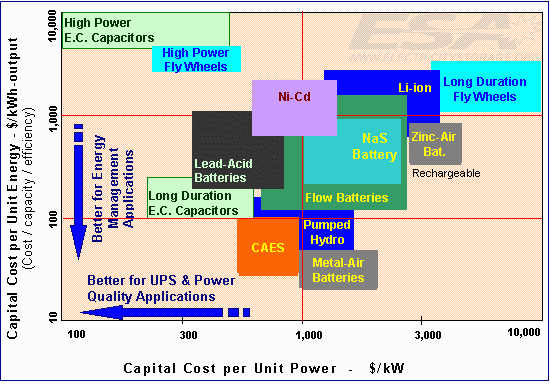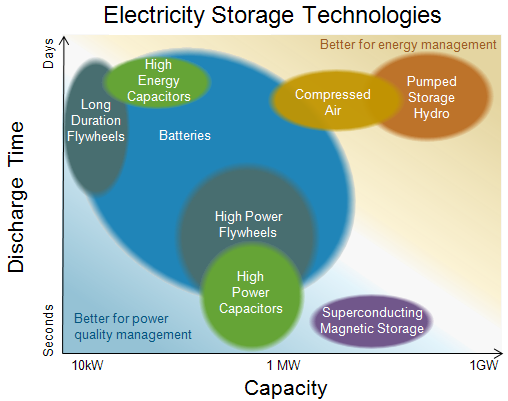This will be the last blog to deal directly with storage technologies. I listed the various technologies in the July 29th post, then followed that up last week, mainly focusing on estimates of future capacity and the investments that will be needed to decarbonize the energy supply. The necessarily increased reliance on sustainable energy sources requires investing in technologies that separate energy generation from energy use, users from producers. If we go into the specifics of the storage technologies that I mentioned in the July 29th blog, the following picture emerges:

Power quality determines the compatibility between various types of electrical power and consumer devices. An important consideration in such a match is that the supply power must be uninterruptible (UPS). I have discussed the difference between energy and power before; here, the horizontal axis refers to the initial capital cost for the storage device per unit of power (in kw) that it can deliver, while the vertical axis refers to the cost per unit of energy stored over the lifetime of the device.
Cost is not the only consideration that determines which technology to use. The uninterruptible power requirement necessitates that the system be able to quickly respond to changes in supply and demand. Long-term changes in terms of weeks or months are relatively easy to predict and offer sufficient time to adjust changes in supply with changes in demands. Short-term changes – such as heat waves, which require immediate adjustment in power, as needed for air conditioning – are more difficult to predict and adjust to. Many of the recent grid blackouts have emerged as a result of such short-term surges in demand. The various storage devices’ compatibilities are measured by their discharge times. These characteristics are shown in the figure below:
Capacity, again, is a measure of the power of the devices.
The scales in both graphs are logarithmic scales (August 6, 2012) in which equal distance on the axes indicates factor of ten differences in value. (In other words, the differences are large)
The need for storage capacity recently reached the big news with Tesla Motors’ announcement of a plan to construct a Gigafactory for Li-ion batteries for its electric car fleet; a project with an estimated cost of $4 billion. Panasonic has now decided to join this effort, investing both money and equipment. The factory aims to start producing batteries in 2017.
Why did Tesla choose the Li-ion over the Lead-Acid battery? The first figure clearly shows that the Li-ion batteries are more expensive both per unit of power and per unit of energy as compared to lead-acid batteries, so other considerations must be at play. The Gigafactory is targeted toward supplying batteries for electric cars. This means weight must be another important factor. The table below shows the energy stored in the two batteries per unit of weight of the battery. This parameter is known as the energy density. The data in the table are based on those in the Wikipedia entry. The energy density of the two batteries is shown in comparison with that of gasoline. The energy density of Li-ion is four times higher than that of lead-acid batteries but is still about 75 times lower than that of gasoline. These numbers indicate the relative advantage of the Li-ion over the lead-acid battery but at the same time convey the enormous challenge facing manufacturers of electric cars as compared to those that make gasoline-driven vehicles.
|
Storage device |
Specific Energy (MJ/kg) |
Specific Energy (kwh/Lb) |
|
Gasoline |
46 |
5.86 |
|
Li-ion battery |
0.62 |
0.08 |
|
Lead-Acid battery |
0.17 |
0.02 |
A word about the units in the table: The two right columns present the same data in different sets of units: the right column corresponds to the units that are predominantly used in the US, while the central column is given in units widely accepted in the rest of the world. The conversion is as follows: 1MJ = 0.28kwh; 1kg = 2.2Lb. It is a great exercise to try this conversion – especially for American readers – because it helps open our windows of comprehension to more global information.
* I always welcome questions and comments about my blog, my book, and my work in general. Unfortunately, I have been deluged with spam – both in the comments section here, and in my email. In the interest of spending my time addressing actual messages (instead of sorting through junk), I ask that you please send any questions to one of the following addresses, with the title, “Comment about CCF blog.”
micha (no space) tom (at) brooklyn (dot) cuny (dot) edu
or info (at) lcgcommunications (dot) com. Thank you for your continued readership and your feedback.

